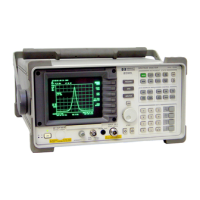Note
If the frequency calibration CAL
FREQ
and the amplitude calibration
CAL AMPTD self-calibration routines are used, the frequency calibration should
be performed before the amplitude calibration, unless the frequency data is
known to be accurate.
The CAL
FREQ
softkey
starts the frequency self-calibration routine. This routine adjusts the
frequency, sweep time, and span accuracy in approximately 2 minutes.
The CAL AMPTD
softkey
starts the amplitude calibration routine. This routine takes
approximately 3 minutes (7 minutes with Option 130) to adjust the bandwidths, log and linear
switching, IF gains, IF frequency centering, RF attenuation, and log amplifier. When the
amplitude calibration routine has finished, the preset display returns and CAL DONE is displayed.
Although the spectrum analyzer stores the correction factors in battery-backed RAM, the
data will not be saved when the spectrum analyzer power is turned off unless the data has
been stored with CAL STORE . Using CAL
STURE
stores the correction factors in an area
of spectrum analyzer memory that is accessed when the spectrum analyzer is turned on.
After the frequency and amplitude self-calibration routines are complete, CORR (corrected)
now appears on the left side of the screen, indicating that the spectrum analyzer is using its
frequency and amplitude correction factors. Correction factors can be turned off by pressing
CORRECT ON OFF . When OFF is underlined, most amplitude correction factors and some
frequency correction factors are not used.
If the self-calibration routines cannot be performed, see “Check the Basics” in Chapter 9.
Performing the Tracking Generator Self-Calibration Routine
(Option 010 or 011 only)
In order for the tracking generator to meet its specifications, allow the spectrum analyzer
to warm up for 30 minutes after being turned on before attempting to make any calibrated
measurements. Be sure to calibrate the spectrum analyzer and the tracking generator only
a&r
the spectrum analyzer has met operating temperature conditions.
Note
Since the tracking-generator self-calibration routine uses the absolute
amplitude level of the spectrum analyzer, the spectrum analyzer amplitude
should be calibrated prior to using CAL TRK GEM .
1. To calibrate the tracking generator, connect the tracking generator output (RF OUT 500) to
the spectrum analyzer INPUT
5OQ
connector, using an appropriate cable and adapters.
Note
A low-loss cable should be used for accurate calibration. Use the
5Ofl
cable
shipped with the spectrum analyzer.
(fir
Option 001
or
012:
use the 750 cable
shipped with the spectrum analyzer).
2. Press the following spectrum analyzer keys:
m),
More 1 of 4, More 2 of 4, and
CAL TRK GEN . TG SIGNAL NOT FOUND will be displayed if the tracking generator output is
not connected to the spectrum analyzer input.
3. To save this calibration data in the area of spectrum analyzer memory that is saved when
the spectrum analyzer is turned off, press (CAL) then CAL STORE.
Getting Started
2-17

